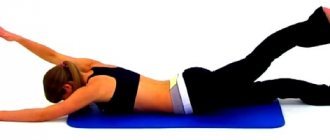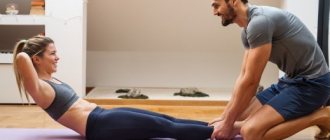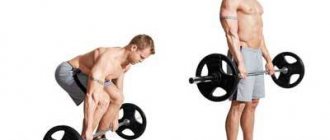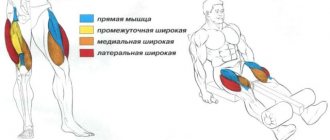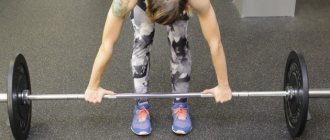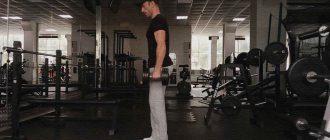A decisive role in creating a perfect figure, both when gaining weight and when losing weight, is played by exercises with weights, for example, with a barbell. The most common sports equipment is a barbell, which is actively used in men's and women's training. There are several types of barbells, each designed for specific exercises and purposes. Let's consider the theoretical provisions about the equipment and practical methods of training with a barbell at home.
- Types of rods
- Standard rod
- Olympic barbell
- Powerlifting barbell
- Groups of vulture species
- Benefits of doing barbell exercises at home
- A set of effective exercises with a barbell for women and men
- Bench press for girls and men
- Deadlift for the back at home
- Video instruction: nuances of deadlift technique
- Bent-over barbell rows at home
- Video tutorial: Bent-over barbell row
- Squats
- Video instructions for performing squats with a barbell
- French press with barbell (dumbbells)
- Video tutorial: technique and nuances of performing the French press
- Barbell curl
- Video instructions for lifting barbells for biceps
- Barbell up press
- Video instruction: lifting the barbell up
- Close-grip barbell row to the chin
- Video training for deltoid muscles: standing barbell row to the chin
- Lunges with a barbell
- Video instruction on lunges with a barbell on the shoulders
- Press press
- The best video tutorials on the press press
- Barbell training program at home
- Program No. 1 “Block”
- Program No. 2. “Free” with warm-up.
Types of rods
To use the projectile correctly, you need to study its components.
Standard rod
The classic (standard) version of the barbell is a barbell - a horizontal metal rod - on which training discs with internal threads are mounted, secured with fastenings. This equipment can be used in a wide variety of exercises if no other options are available. There are always two or three standard barbells in the gym.
Technical characteristics of the classic bar: weight, diameters, length
Technical characteristics of the classic rod: weight of components, diameters, length
Olympic barbell
The Olympic barbell has a number of features that make it more maneuverable. The “Olympic” bar is made of high-quality steel, the weight is distributed evenly, the bar has Kraevsky markings, the rod has high strength properties. In addition, the rod has special bushings secured in bearings. Typical characteristics of the projectile: weight - 20 kg, length - 2.2 m, diameter - 28 mm, bushings 50 mm. The Olympic barbell is most often used in the training complexes of professional athletes.
Types of Olympic barbell: the main feature is the mounting of the discs - bushing + bearing
Powerlifting barbell
The bar of a powerlifting barbell has a larger diameter than an Olympic barbell. When working with a barbell, oscillatory movements practically do not occur. The equipment is designed to work with large weights (the weight of discs can reach 50 kg).
Technical characteristics of the barbell and its components for powerlifting
Close grip press
Another basic exercise for developing triceps, the starting position assumes a grip width of 25-30 cm, but not 5 cm, as many do. A position that is too narrow will not engage the triceps well enough and will put the wrists in an uncomfortable position, which can get injured under heavy weights.
It is important to breathe correctly during the exercise, under no circumstances hold your breath; when lowering during the relaxation phase, inhale; when ascending during the effort phase, exhale.
Detailed technique and a visual video of the exercise are here.
Groups of vulture species
The bars that form the basis of the barbell can look different and, accordingly, be used in different exercises:
- The EZ bar is a curved bar that does not break your wrists when performing French presses, biceps curls, and overhead triceps rows.
- The W-bar is a highly curved bar that allows you to use an overhand grip when performing triceps and outer biceps exercises.
- Trap bar is a design for performing exercises with a parallel grip (for example, deadlifts).
Varieties of bars for performing various strength exercises with a barbell
How to correctly calculate the working weight in an exercise?
All exercises that athletes perform in gyms are usually divided into two main classes, isolating (single-joint) and basic (multi-joint), that is, they involve two or more joints when performing a working movement.
The basis for calculating working weight should be percentages (%) of the maximum possible weight that you can lift in a given specific exercise. For example, there are concepts that are closely related to the training program in the gym, such as light, medium, and heavy training. So, light training means the working weight in the exercise is 60-65% of the maximum, medium 70-75%, and heavy 80-85%.
Calculation of working weight in an exercise
Let us consider below, using a specific example, the calculation of the working weight when performing a barbell bench press while lying on a horizontal bench.
Benefits of doing barbell exercises at home
Working out with a barbell has a number of advantages, among which the most important is the growth of muscle mass. With regular exercise, muscles tend to develop and strengthen. Not only strength training for men should include various exercises with a barbell: women's training complexes, the goal of which is to increase muscle volume and create a beautiful relief, should consist of exercises with weights, in particular, with an EZ-barbell and a classic bar.
It is impossible even for male athletes to pump up muscles through gym training alone, so the barbell cannot be categorically considered a forbidden piece of equipment. Only if you have health restrictions, you can refuse such workouts in favor of cardio, gymnastics and bodyweight exercises. If your goal is to gain/lose weight, then the barbell is one of the best weapons in the fight for an athletic figure for both men and women.
Another advantage of using equipment is the acceleration of metabolism, which makes you quickly get rid of excess fat (including subcutaneous fat - during the period of intense drying). In addition, periodic weight training increases strength and endurance, comprehensively exercises the muscles and promotes harmonious physical development.
h
V
Results of women's strength training: before and after training with weights (dumbbells, barbells, weights)
Fundamental Training Principles
Warm up before a tough workout
Before you begin the training program, you should do a warm-up. It will help to properly warm up the muscles, joints and ligaments, preparing them for work. A little cardio activity, such as a treadmill or exercise bike, is also good. Of course, if you got to the gym on foot or by bike, then consider that you have already completed cardio training. Don't forget about stretching the muscle groups you are going to work on. Especially such as elbows, knees and shoulders. All this will help you avoid unnecessary injuries.
More is not better
You don't need to do a bunch of exercises in one workout. Gaining mass involves an hour-long workout with 5-6 exercises. Consequently, a long workout will only tire the muscles, and instead of growing, they will begin to self-destruct. This phenomenon is called catabolism.
Warm-up approaches
Be sure to use 1-2 warm-up approaches before the main ones. This will prepare the muscles for work by filling them with blood. And along with it, nutrients, oxygen and vitamins enter the working muscle. Also, by performing such approaches, you will create a kind of neuromuscular connection and practice the correct technique.
Do many sets of basic exercises
This is a key point in mass training. Instead of the standard 4 sets of 10 reps. When working on mass, it is better to use 7-10 sets of 3-5 repetitions. Of these, 1-3 are warm-up. This is done so that your muscle has time to properly prepare for the next approach. During rest, the muscle is filled with blood and thus warms up well. Also, a small number of times in the approach we will reduce the amount of lactic acid formation. This will have a beneficial effect on muscle growth. Since a large abundance of lactic acid is accompanied by muscle weakness and pain, especially in those parts of the body that we affected.
Work to the max
Another important point. In the last two approaches, you should select such a weight that it is not easy for you. Ideally, ask someone for help to get the most out of it.
Proper diet
For many, it’s no secret that in order to gain weight you need to eat right. To achieve this, a large amount of calories, nutrients and vitamins are consumed. Also, don’t forget to drink plenty of fluids. You can learn more about nutrition from the article “Principles of Proper Nutrition“
Rest between workouts
You should also know that muscles do not grow during training, but during rest. Therefore, you should not start the next workout if you have not recovered properly. Firstly, you will achieve nothing except overtraining. And secondly, this can have a very strong impact on the psyche and you simply don’t want to go to the gym and subject yourself to such stress. And this is where your training ends. But the worst thing is that lack of rest can lead to injuries.
These points are mandatory. Without them, muscle growth is impossible
Therefore, pay special attention to them. And it is advisable to find a training partner who will share your goals
It will also help you achieve the desired result. If there is no such person, then you can turn to the services of a trainer or people who work out in the gym. The next step for you is to break down your body into muscle groups.
Barbell training program at home
Program No. 1 “Block”
BLOCK 1. Arm training.
- Barbell up press (3×8).
- Barbell curl for biceps (3×15).
- French press (3×12).
BLOCK 2. Chest training.
- Bench press (3x8).
- Seated barbell press (2×10).
BLOCK 3. Leg training.
- Barbell squats (3×15).
- Barbell lunges (2×15).
- Deadlift (3×12).
BLOCK 4. Back training.
- Bent-over barbell row (3×15).
- Barbell row to the chin (3×8).
Program No. 2. “Free” with warm-up.
- Burpee (5 minutes).
- Push-ups (3×10).
- Barbell lunges (3×15).
- Barbell squats (3×15).
- Bent-over barbell row (3×8).
- Barbell curls (3×12).
- Shvung press (1x7).
- Plank (3 sets of 1 minute).
Exercises with a barbell at home, by and large, form the basic basis for strength training for girls and men. Therefore, it is important to be able to use the apparatus and select the right equipment to perform complex and sometimes multi-joint exercises. At the initial stage of training, you can only work with the bar. Once you have perfected the basic techniques, gradually increase the load using removable discs. Working with additional weights is a direct path to an athletic, proportionately developed figure. In conjunction with proper nutrition, strength training will help you quickly achieve high results.
What is the Russian cycle?
Russian cycle (program)
The Russian cycle is a two-month powerlifting training regimen consisting of three sessions per week. They perform only competitive exercises: squats, bench presses and deadlifts.
This is a popular training regimen. It is used by both beginners and experienced athletes. It gained popularity for a reason: the program is an electronic tablet that itself calculates the working weight, the number of approaches and repetitions. You just need to introduce rep maxes into competition lifts.
You can find out more about the technique of performing exercises for the Russian cycle in the exercise database:
Bench press
- MechanicalBasic
- Muscle load
- Working muscles: Pectorals
- Accessory muscles: Anterior deltoid, Triceps
- Pectoral muscle Working muscle
10 / 10 - Anterior deltoid Accessory muscle
6 / 10 - Triceps Accessory muscle
3 / 10
Squats
- MechanicalBasic
- Muscle load
- Working muscles: Quadriceps femoris
- Accessory Muscles: Glutes, Back Extensors, Biceps Femoris
- Quadriceps femoris Working muscle
10 / 10 - Buttocks Accessory muscle
8 / 10 - Back extensors Accessory muscle
6 / 10 - Biceps femoris Accessory muscle
4 / 10
Classic deadlift
- MechanicalBasic
- Muscle load
- Working muscles: Biceps femoris, Back extensors
- Accessory Muscles: Forearm, Glutes, Abdominals, Adductors, Calves, Back, Quadriceps
- Biceps femoris (biceps femoris) Working muscle
10 / 10 - Back extensors Working muscle
10 / 10 - Abdominal muscles Accessory muscle
6 / 10 - Quadriceps (quadriceps) Accessory muscle
5 / 10 - Back muscles Accessory muscle
4 / 10 - Biceps Accessory muscle
3 / 10 - Forearm Accessory muscle
2 / 10
I am attaching a link to download this training program:
Russian cycle
Powerlifting training program.
Download file from website
Features of the Olympic Straight Barbell
The most popular weights used by athletes in training and competitions are weightlifting barbells. Such equipment is the best option for quickly building muscle mass and forming a beautiful body contour. A professional straight barbell consists of a bar and weight plates of different weights, which are painted in standard colors. In our online store you can buy any option, equipped with discs in blue, yellow, red, green, black, each of which corresponds to a specific weight.
A sports barbell with colored weights, used in competitions, differs from a regular barbell in its larger diameter. The neck has increased strength. It is important to note that, if necessary, you can buy equipment equipped with a training bar that can withstand a load of up to 600 kg.
Before sale, all competition equipment presented in our catalog undergo mandatory testing, after which each is assigned a number and issued a certificate. Our company managers will help you find out the cost and buy a straight barbell for both training and competitions.
Technique for performing exercises with a curved barbell for biceps
By selling equipment for equipping gyms, fitness clubs and sports centers, we offer their owners to buy a barbell with a curved bar complete with other equipment, which will be appreciated by professional powerlifters and bodybuilders. A significant advantage of equipment with a curved neck is its ease of use. The maximum load when working with this projectile falls on the biceps brachii muscles. Basic exercises with a curved barbell for biceps allow you to effectively develop the middle, lower and upper parts of the muscles. It is extremely important to follow the correct technique:
- Take a stable position with your feet shoulder-width apart.
- Grab the projectile by the corners of the bar.
- Bend your knees and grasp the apparatus, keeping your back straight as you lift it from the floor.
- Lift the weight and step back one step when removing it from the rack.
- The starting position is a barbell with a curved bar in your arms, with your biceps fully stretched and your torso slightly tilted forward.
- With a sharp movement, lift to your chest, straightening your torso in the process.
- Slowly lower the projectile to its original position, and slightly tilt your torso forward.
- After completing the required number of approaches, carefully lower the apparatus onto the counter or floor.
In order to get the maximum benefit from this exercise, it should be performed using a free technique: the torso of the practitioner should be slightly tilted forward. In this case, a curved barbell for biceps will allow the athlete to avoid injuries during training and develop greater endurance. Very strict execution technique and keeping the body straight are unnatural, which is why the athlete will not be able to lift heavy weights.
Free technique involves lifting the barbell in accordance with the natural biomechanics of the practitioner’s body. That is why buying a biceps barbell with a curved bar is the best solution if you want to quickly pump up this muscle. You can hold a heavy projectile either by the outer or inner corners of the bar. By experimenting with the width of the grip, the athlete will find a position in which he can exercise with maximum weight, so you can additionally buy a set of sports weights.
It is necessary to work with full amplitude, that is, make sure that the biceps are completely stretched at the bottom point of the movement, and contracted at the top. You should also control the weight without swinging the barbell. This is especially important during the negative phase of the exercise, that is, lowering the projectile to its original position. In our online store you can buy a standard biceps barbell or one manufactured in accordance with the customer’s individual requirements at an affordable cost.
The principle of working with a projectile
You may be interested in: How to reduce calves
The barbell was invented in order to introduce balanced loads into classes. It is great for establishing balance. For example, training at home with a barbell might involve doing an exercise where one end of the barbell is sandwiched between two walls while the other end is lifted up like a lever. When performing, you can feel that working with a barbell causes less stress on the shoulders and activates the core muscles to a greater extent.
